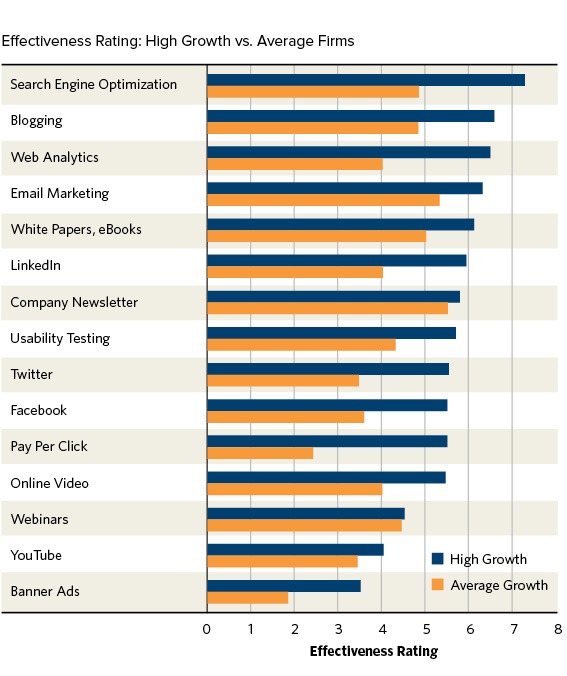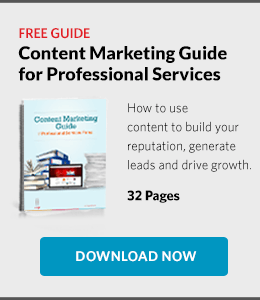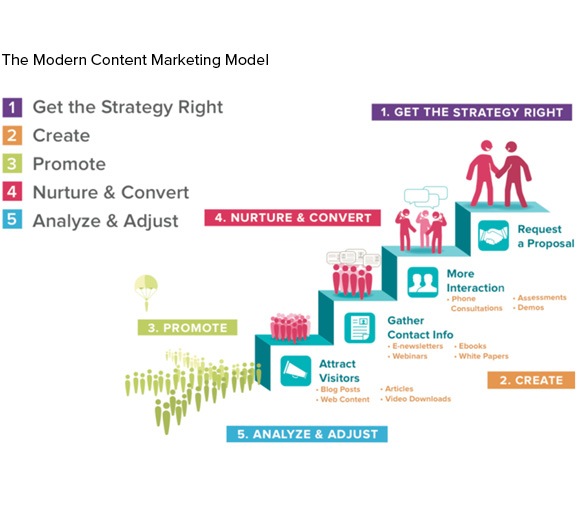The Road to Revenue, Part 3: The Content Marketing Toolbox

So far in this series, we’ve explored how the explosion of information online has changed how buyers buy, and why business development insights can be essential to effective content marketing. Now let’s take a look at the content marketing tools that carry your expertise to the right audience.
Educational Content and High Growth
When your firm starts assembling its marketing toolbox, it makes sense to ask, “Which tools work?” After all, if a tool or technique isn’t going to make a demonstrable contribution to the bottom line, then why bother?
For answers, we can look to our studies on the marketing strategies used by average and high growth businesses. Our research shows a major difference in the way high growth and average growth firms approach content and digital marketing more broadly.
The chart below shows how 500 professional services firms focused their efforts, with a stark difference between the high and average growth firms.
The top techniques used by high growth firms – blogging and search engine optimization – are dramatically underutilized by average growth firms. The same goes for Twitter and web analytics. High growth firms are building out consistent, issue-oriented online marketing programs and amplifying the contents’ reach with social media, while the rest of the pack makes only a patchwork effort.

What’s more, the research shows companies that blog regularly see 50% more traffic and 70% more leads. Why? Not only does educational content like blog posts help boost your firm’s credibility and share your expertise, it also helps raise your visibility in search engines — so prospects with the kind of problems you solve are likelier to find you when they go looking for solutions.
SEE ALSO: Top 10 Marketing Techniques for Professional Services
Long after you or your firm’s other experts have written and posted a blog, that content keeps working for you by raising your profile in searches and educating potential clients who you might not even know are out there. You can think of robust educational content that will remain relevant for years to come — sometimes called “evergreen content” — as a long-term investment in your brand, and ultimately in your bottom line.
A Content Marketing Strategy
Your firm may be using disparate digital marketing tools like an email list or Google+ page. But to be truly successful — to effectively generate leads — they should all be deployed as part of a comprehensive content marketing strategy. Find out if your marketing department has such a strategy…and if not, encourage them to formulate one.
This strategy will identify target audiences for your content, and how each type of content your firm produces will help nurture leads. An effective content-driven business development funnel can be represented as a set of stairs:

In this model, prospects (leads) effectively qualify themselves. At first, they’re drawn to your website by free educational content that helps them get educated around a pressing problem. (At this stage, your expertise can help ensure that your content is genuinely useful for your buyers.) Attractive offers for more in-depth content encourage them to trade their email addresses for resources like ebooks and whitepapers. With the emails in hand, your firm can make targeted, educational offers for progressively higher commitment engagements like webinars and free consultations. By the time they’re ready for services, you’re top of mind — the prospect already knows who you are and how you think. This is called the Lead Nurturing Model.
In this approach, it’s the marketing department’s job to draw prospects (leads) deeper into the business development funnel with strong content and offers, guided by your understanding of clients and the marketplace. When marketing does its job right, this eventually prompt leads to pick up the phone and call — when they’re ready. And this point is key: unlike in the traditional business development model, leads are ready to engage in a relationship when they reach out to you. In short, these are prequalified leads. For business development, their job is not only to close those prospects that are ready to commit, but to also be on the lookout for issues and topics that can be converted into relevant and targeted content for prospects.
The challenge here, of course, is that for the content marketing process to work as I’ve described it above, business development and marketing will need to coordinate closely. And at many firms, the two departments just aren’t used to this kind of collaboration. In our next post, we’ll show you how to lead a more effective joint effort between business development and marketing.
Download our Content Marketing Guide for Professional Services to find out more about developing a successful content marketing campaign.
On Twitter or LinkedIn? Follow us @HingeMarketing and join us on LinkedIn.

Industries & Topics
Most Popular
- Business Development Strategy: A High-Growth Approach
- A 10 Step Brand Development Strategy for Your Professional Services Firm
- Strategic Marketing for Professional Services
- Digital Branding for Professional Services
- 10 Essential B2B Marketing Strategies to Grow Your Professional Services Firm
- Digital Marketing Strategy for Professional Services
- Rebranding Strategies: A Step-By-Step Approach for Professional Services
- Elements of a Successful Brand 1: Brand Positioning
- The Top 5 Business Challenges for Accounting & Financial Services Firms
- Find Your Differentiator: 21 Ways to Gain a Competitive Advantage for Your Firm
- Elements of a Successful Brand 4: Brand Promise
- What Is the Cost of Video Production for the Web?





Leave a Comment